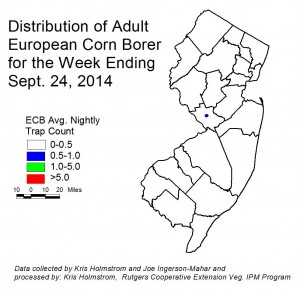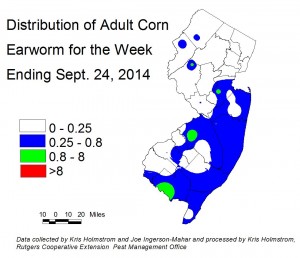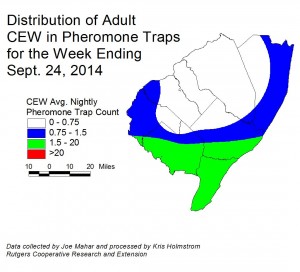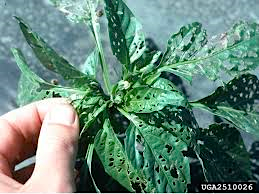Topics for the Week
- Sweet Corn
- Peppers
- Tomatoes
- BMSB
- Pumpkins and Winter Squash
- Cole Crops
Maps for the Week
–European Corn Borer Map
–Corn Earworm Moth Blacklight Trap Map
–Corn Earworm Moth Pheromone Trap MapVegetable IPM Report 9-24-14 – Click to View | Download | Print
Sweet Corn
European Corn Borer (ECB) adult activity is very low. This week’s map shows only a small pocket of activity in central Mercer County (see ECB map). Low numbers of larvae are active in the few remaining whorl and pre-tassel stage plants, but feeding is largely overwhelmed by more dominant fall armyworm (FAW) feeding. As always, consider treating if 12% or more plants exhibit ECB feeding alone, or in combination with FAW (see below) injury. Remember to make a full-tassel application to control ECB larvae as they leave the tassel and travel down the stalk to re-enter the plant near the ear shank. This last application is often critical to controlling ear infestations from ECB.
| The highest nightly ECB catches for the previous week are as follows: | |||||
| Folsom | 1 | Lawrenceville | 1 | Medford | 1 |
| Princeton | 1 | Tabernacle | 1 | ||
Blacklight Trap: Corn earworm moth (CEW) activity has declined further over the past week. With the exception of warmer temperatures over the weekend, most nights for the past week have been cool. This, combined with little favorable weather to assist moth movement, has resulted in low numbers of CEW. CEW moth activity is generally higher in southwestern counties and in Burlington and Ocean counties, but patchy activity may be found anywhere in the state (see CEW blacklight map). Be alert for the possibility of increased activity as we approach the weekend, when higher temperatures are forecast. At these levels, CEW are still capable of significant damage most sweet corn ears if not controlled.
| The highest nightly CEW trap catches are as follows: | |||||
| Medford | 3 | Downer | 1 | Lawrenceville | 1 |
| Jones Island | 2 | East Vineland | 1 | Matawan | 1 |
| Blairstown | 1 | Eldora | 1 | Milltown | 1 |
| Califon | 1 | Georgetown | 1 | New Egypt | 1 |
Pheromone Trap: CEW pheromone trap catches declined significantly over the past week. Greatest activity is still in Cape May County and along the southern Delaware Bay shore (see CEW pheromone trap map). The green area on the map roughly corresponds to a 3-4 day silk spray schedule, while the blue area should be considered in the 5 day range. Low spots within the broader colored areas are outliers, and grower near those areas should defer to the more conservative schedule. Sweet corn plantings now in silk in southern NJ are still at risk for ear infestation if CEW is not properly controlled.
| The highest nightly CEW pheromone trap catches are as follows: | |||||
| Green Creek | 10 | Eldora | 3 | Woodstown | 3 |
Silking Spray Schedules*
South: 5 days
Central: 4-5 days
North: 3-4 days
*Note: These are general recommendations. Local trap catches may indicate some variation in the frequency of insecticide applications to silking corn.
Fall armyworm (FAW) infestations are ongoing throughout the state, although infestations seem to be slower to develop now. It is important that all plantings be scouted regularly for this pest. FAW will also infest ears, although the silk spray schedule for CEW usually eliminates them from the plants at that time. Consider treating if the number of plants infested with FAW either alone, or in combination with ECB exceeds 12%. FAW may be difficult to control with pyrethroid insecticides. Newer materials, including spinosad-based insecticides, as well as those including active ingredients chlorantraniliprole and flubendiamide are effective against BAW.
Foliar Diseases of Sweet Corn will remain with us for the duration of this season. These include corn leaf rust (CR) and northern corn leaf blight (NCLB). Both CR and NCLB can negatively impact ear development if they become heavy on foliage. CR causes ruptures in the leaf surface, resulting in moisture loss that stresses the plant. NCLB reduces the amount of photosynthetic surface available to the plant. Both are more serious the earlier they develop on corn plants. Generally, if the first signs of disease occur after the pre-tassel stage, damage will likely be confined to cosmetic blemishes on the husk. If infections first appear in the whorl stage, the possibility exists for ear size to be reduced as the plants struggle to compensate for water loss and reduced leaf surface. Consult the 2014 Commercial Vegetable Production Recommendations for specific fungicide recommendations, but be aware that the strobilurin class (FRAC Grp. 11) has provided poor results on NCLB in the northern parts of the state.
Peppers
Beet armyworm (BAW) have been captured in southern counties. Most traps are catching just a few moths, although numbers in the Woodstown area have jumped to over 40/night for the past week. Pepper fields in this area should be scouted weekly for the appearance of BAW injury. BAW larvae will feed on leaves near the growing terminals of the plants, resulting in shredded foliage at the top (see photo). As the larvae molt and grow larger, they will begin feeding on fruit. BAW, like FAW is difficult to manage with pyrethroid insecticides. Materials that are recommended for FAW control (see the FAW paragraph above), will also be effective against BAW.
Tomatoes
Late Blight: IPM personnel have discovered no infections on commercial fields in New Jersey. All growers with late season tomatoes should scout their fields several times a week. Should wet weather move in (as is possible by tomorrow) or new reports of late blight occur, growers should apply fungicides that specifically target late blight in addition to their normal protectant fungicide program. For organic growers, fixed copper formulations should be applied preventively and at frequent, regular intervals to provide coverage to new growth. Individual plants showing late blight symptoms should be rogued.
Brown Marmorated Stinkbug (BMSB)
BMSB trap catches are nearly non-existent. Adult activity continues to be well behind previous years. Although unlikely, if adult captures increase to 5/night for a full week, maps will be produced to show where activity is highest. Information on scouting, crop injury and control will also be included. It is noteworthy that August and September BMSB infestations in pepper fields in Warren County required treatment last year. This year, no BMSB have been sighted on the same crop fields.
Pumpkins and Winter Squash
Cucurbit downy mildew (CDM) is active on cucumbers in New Jersey. Recently, CDM has also been found on cantaloupe in Cumberland County. Reports from PA and NY indicate that DM is impacting cucumbers there. As of this Tuesday, IPM personnel have detected no other cucurbit crops with DM infections. However, given the virulence of CDM, it is advisable that pumpkin growers begin to add fungicides that specifically target CDM to their regular protectant program for powdery mildew (PM).
The CDM website http://cdm.ipmpipe.org/ indicates minimal risk of spread into New Jersey for the first part of this week. The latter half of this week will bring rain from the south. This may increase the chance of CDM infections by the weekend. It is important to note that other infection sites in neighboring states are cucumber infections. Heavy dew periods will cause existing field infections to worsen unless excellent coverage with proper fungicides is achieved. The CDM website should be a “favorite” on every grower’s web browser. It is advisable that all growers scout crops at least twice a week. Any further occurrence will be reported in this newsletter and will also generate an alert to all subscribers.
Powdery mildew (PM) is active on vine crops in all areas. Check upper and lower surfaces of 2 mature leaves per plant on 5 consecutive plants each, in 10 locations throughout the field. When PM lesions are found on 2 or more leaves, begin a weekly protectant fungicide program. See the 2014 Commercial Vegetable Production Recommendations for materials useful in managing CDM and PM. It is critical that recommended fungicides be rotated to reduce the possibility of the organism developing resistance to effective materials.
Many fields of pumpkins and winter squash are now mature (fruit rinds are hardened off with color, and handles are solid). Inspect fields and determine whether it is necessary to continue spraying fungicides. If fruit are mature, and are to be removed from fields with increasing regularity, it is acceptable to discontinue the program. IPM personnel have noted that as foliage declines, exposing fruit to deer, more injury from these animals occurs. Prompt removal of fruit from the field may be the best response as foliage declines.
Cole Crops
The pest situation for cole crops remains unchanged. Cabbage looper (CL) infestations are fairly common, as well as diamondback moth (DBM), imported cabbage worm (ICW). In central NJ, a few beet armyworm (BAW) larvae have begun to turn up in samples. BAW may impact plantings in Salem County as well, given the high pheromone trap catch in the Woodstown area. Scout plantings weekly. Check 5 consecutive plants each in 10 random locations throughout the planting, paying particular attention to the innermost leaves where ICW often feed. Consider treating if caterpillars are found on 10% or more plants that are in the 0-9 true leaf stage. From 9-leaf to the early head stage (in broccoli, cauliflower and cabbage) infestations up to 20% may be tolerated. Once heads begin to form, a 5% threshold should be observed to protect the marketable portion of the plant. For leafy greens such as collards and kale, 10% plants infested is the threshold throughout. It is important to identify DBM and BAW correctly, because if it present, synthetic pyrethroid insecticides may not provide acceptable control. DBM larvae are small, and taper toward both ends. They thrash vigorously when disturbed. BAW are green with a pale stripe down each side and a prominent dark spot on each side of the second segment behind the head.
Broccoli and collard plantings are developing crucifer downy mildew (CrDM) infections. CrDM caused necrotic spots to develop on the upper surface of older leaves. Inspection of the lower leaf surfaces will show pale purple sporulation (see photo at right) erupting from the infected tissue. This disease can be especially hard on broccoli and collard greens, so growers should actively scout plantings at least weekly. Cole crops should be treated with appropriate fungicides at the first occurrence of this disease. Consult the 2014 Commercial Vegetable Production Recommendations for specific fungicide recommendations.
All current and archived Vegetable IPM Maps including European corn borer, corn earworm and brown marmorated stink bug population maps are available for viewing @ http://tinyurl.com/njaes-ipm-maps





